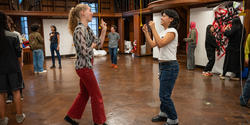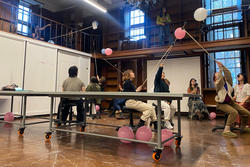Off-campus exhibitions showcase the exceptional work graduate students make in RISD’s Ceramics, Painting, Photography and Sculpture departments.
RISD Course Investigates Collaborative Play as Key to the Creative Process

Students in an an elective studio called Games We Play are exploring collaborative play as an integral element of artmaking and the creative process. Offered through the Painting department, the course explores the psychological and historical foundations of play in artistic expression.
Associate Professor Meena Hasan and Assistant Professor Kelley-Ann Lindo are leading the class and encouraging students to explore games as a tool for making meaning in their own studio practices. The course investigates play and collaboration as fundamental components of the ideation and object-making processes while facilitating a range of radical, interdisciplinary approaches to artmaking.
“We are thinking through philosophies as we develop games and game characters like the hero and the trickster,” Lindo says. “All of the games have to be tactile with players using their hands or full body.”
“It's an effort towards interdisciplinary collaboration,” Hasan adds. “No matter what medium you’re working in, this level of creativity, imagination, risk-taking and experimentation is a connective thread between all thinkers and makers.”


The course is structured around three group critiques, frequent class discussions, individual meetings, presentations and both in-class and out-of-class work. On a Monday afternoon in November, students presented a series of dexterity games they created in teams.
One game titled Fill in the Blank was inspired by Cards Against Humanity. Students designed photos and illustrations with a blank area that needed to be filled in. Participants grabbed sheets of paper and had three minutes to draw something to fit in the spot. One prompt showed a drawing of a waiter lifting the cover off a platter. The group then had to draw what they thought could be on the plate. One student created a detailed drawing of a human head, while another wrote out the word beef. A different judge picked their favorite for each round, and the winners were awarded medals.
Later in the month, Assistant Professor Kerry Downey visited the group to discuss how play and games function in their practice. Downey began the visit by asking the class to pair up for a counting game that began simply enough but got harder and harder as the numbers were replaced with random gestures and sounds. The room filled with various clicking noises, whistling, clapping and giggling as the students attempted to focus on making the gestures in the right order. “At some point it was like we became the same person!” one student exclaimed.
These activities—and the course as a whole—are meant to illuminate the structure, politics and principles of tabletop games and create conversation about aspiration, perseverance, individualism, teamwork, success, failure, vulnerability and desire.
“It's such a privilege to put language to the idea of play as a core tenet of every creative practice and to unpack different approaches and disciplines,” Hasan says. “I hope the students leave the class with the ability to take more risks in whatever area they work in and get out of their comfort zones,” Lindo adds.
Kaylee Pugliese
November 21, 2024


